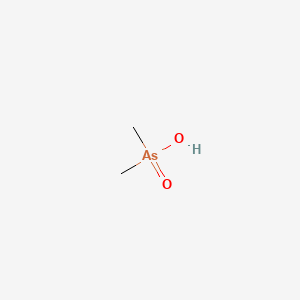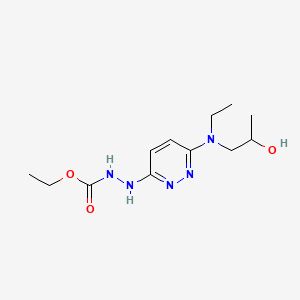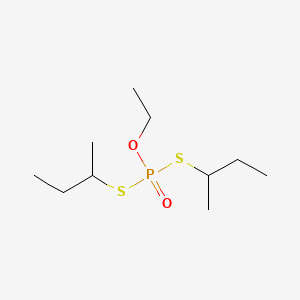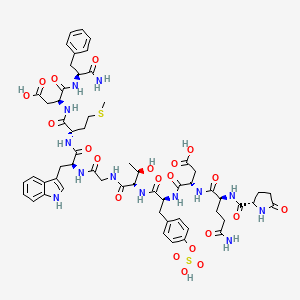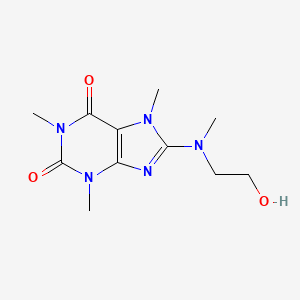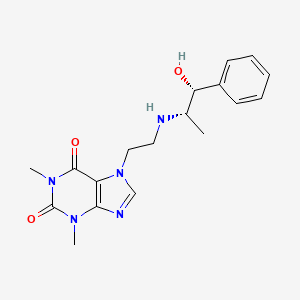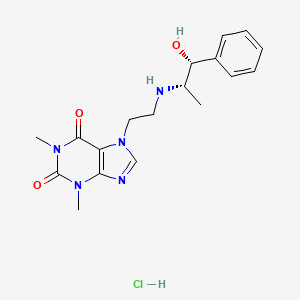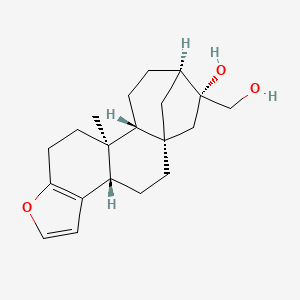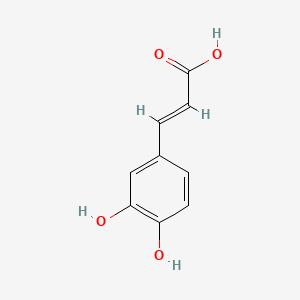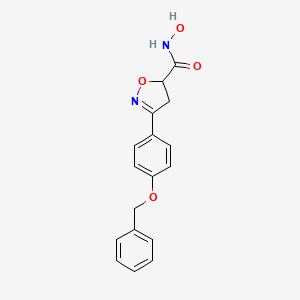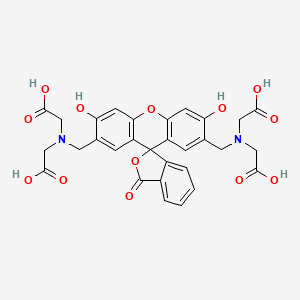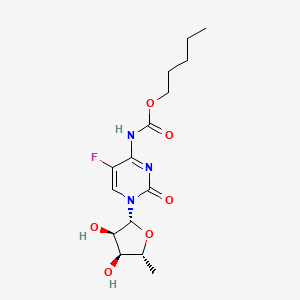
カペシタビン
概要
説明
カペシタビンは、転移性乳がんや大腸がんを含むさまざまながんの治療に使用される経口投与の化学療法薬です . これは、腫瘍内でフルオロウラシルに酵素的に変換されるプロドラッグであり、DNA合成を阻害し、腫瘍組織の増殖を遅らせます . カペシタビンは、DNA合成を阻害することによりがん細胞を殺す抗代謝物と呼ばれる抗悪性腫瘍薬のグループに属します .
2. 製法
合成ルートと反応条件: カペシタビンは、複数段階のプロセスを経て合成されます。 合成には、5-デオキシ-5-フルオロシチジンとペンチルクロロホルメートの反応が含まれ、中間体が形成され、さらに反応させてカペシタビンを生成します . 反応条件としては、通常、エチルアルコールなどの溶媒を使用し、目的の生成物が得られるように温度とpHを厳密に制御する必要があります .
工業的生産方法: カペシタビンの工業的生産には、ラボでの合成と同様の反応条件を用いた大規模合成が含まれます。 このプロセスには、製品の安定性と品質を確保するために、化合物のふるい分け、ペレット化、乾燥、成形が含まれます . 高性能液体クロマトグラフィー(HPLC)や高性能薄層クロマトグラフィー(HPTLC)などの高度な技術が、品質管理やカペシタビンの血漿濃度のモニタリングに使用されています .
3. 化学反応解析
反応の種類: カペシタビンは、加水分解、還元、酵素変換など、さまざまな種類の反応を受けます。 主な反応は、体内でのフルオロウラシルへの酵素変換です .
一般的な試薬と条件: カペシタビンのフルオロウラシルへの酵素変換には、カルボキシルエステラーゼ、シチジンデアミナーゼ、チミジンホスホリラーゼ/ウリジンホスホリラーゼが関与しています . これらの酵素は、生理的条件下で加水分解反応と還元反応を促進します。
生成される主要な生成物: カペシタビンの酵素変換から生成される主要な生成物はフルオロウラシルであり、さらに5-フルオロウリジン三リン酸(5-FUTP)や5-フルオロ-2'-デオキシウリジン-5'-三リン酸(5-FdUTP)などの活性代謝物に代謝されます .
4. 科学研究への応用
カペシタビンは、化学、生物学、医学、産業などの分野において、幅広い科学研究への応用があります。 医学では、主に乳がん、大腸がん、胃がん、食道がん、膵臓がんなど、さまざまながんの化学療法薬として使用されています . 化学では、カペシタビンは、プロドラッグとしてのユニークな特性とそのフルオロウラシルへの酵素変換について研究されています . 生物学では、その作用に関与する分子メカニズムと経路の理解に研究の重点が置かれています . さらに、カペシタビンを負荷したナノ粒子は、がん治療の有効性を高めるための標的化薬物送達システムの可能性について検討されています .
作用機序
カペシタビンは、カルボキシルエステラーゼ、シチジンデアミナーゼ、チミジンホスホリラーゼ/ウリジンホスホリラーゼによって順番に体内でのフルオロウラシルに代謝されます . フルオロウラシルはさらに、5-フルオロウリジン三リン酸(5-FUTP)、5-フルオロ-2'-デオキシウリジン-5'-三リン酸(5-FdUTP)、5-フルオロ-2'-デオキシウリジン-5'-一リン酸(5-FdUMP)という3つの主要な活性代謝物に代謝されます . これらの代謝物は、RNAとDNAに組み込まれることでDNA合成を阻害し、細胞死を引き起こします . 分子標的としては、5-FdUMPによって阻害されるチミジル酸シンターゼと、5-FUTPによって阻害されるRNAポリメラーゼがあります .
科学的研究の応用
Capecitabine has a wide range of scientific research applications, particularly in the fields of chemistry, biology, medicine, and industry. In medicine, it is primarily used as a chemotherapeutic agent for treating various cancers, including breast, colorectal, gastric, esophageal, and pancreatic cancers . In chemistry, capecitabine is studied for its unique properties as a prodrug and its enzymatic conversion to fluorouracil . In biology, research focuses on understanding the molecular mechanisms and pathways involved in its action . Additionally, capecitabine-loaded nanoparticles are being explored for their potential in targeted drug delivery systems to enhance the efficacy of cancer treatments .
生化学分析
Biochemical Properties
Capecitabine plays a crucial role in biochemical reactions by being converted into 5-fluorouracil through a series of enzymatic steps. The conversion involves three key enzymes: carboxylesterase, cytidine deaminase, and thymidine phosphorylase . Carboxylesterase hydrolyzes capecitabine to 5’-deoxy-5-fluorocytidine, which is then deaminated by cytidine deaminase to 5’-deoxy-5-fluorouridine. Finally, thymidine phosphorylase converts 5’-deoxy-5-fluorouridine to 5-fluorouracil . These interactions are essential for the activation of capecitabine and its subsequent anticancer effects.
Cellular Effects
Capecitabine exerts significant effects on various types of cells and cellular processes. Once converted to 5-fluorouracil, it interferes with DNA synthesis and repair by inhibiting the enzyme thymidylate synthase . This inhibition leads to the disruption of cell division and induces apoptosis in rapidly dividing cancer cells. Additionally, capecitabine influences cell signaling pathways, gene expression, and cellular metabolism, contributing to its overall anticancer activity .
Molecular Mechanism
The molecular mechanism of capecitabine involves its conversion to 5-fluorouracil, which then exerts its effects at the molecular level. 5-fluorouracil inhibits thymidylate synthase, leading to a decrease in thymidine triphosphate levels and subsequent DNA synthesis inhibition . This inhibition results in DNA damage and cell death. Furthermore, 5-fluorouracil can be incorporated into RNA, disrupting RNA processing and function . These molecular interactions are critical for the anticancer effects of capecitabine.
Temporal Effects in Laboratory Settings
In laboratory settings, the effects of capecitabine change over time due to its stability, degradation, and long-term impact on cellular function. Capecitabine is rapidly absorbed from the gastrointestinal tract and converted to 5-fluorouracil, which has a relatively short half-life . The long-term effects of capecitabine on cellular function have been observed in both in vitro and in vivo studies, demonstrating sustained anticancer activity and potential resistance development over time .
Dosage Effects in Animal Models
The effects of capecitabine vary with different dosages in animal models. At therapeutic doses, capecitabine effectively inhibits tumor growth and induces apoptosis in cancer cells . At high doses, capecitabine can cause toxic effects, including gastrointestinal toxicity, myelosuppression, and hepatotoxicity . These dosage-dependent effects highlight the importance of optimizing capecitabine dosing to maximize its therapeutic benefits while minimizing adverse effects.
Metabolic Pathways
Capecitabine is involved in several metabolic pathways, primarily its conversion to 5-fluorouracil. The key enzymes involved in this process are carboxylesterase, cytidine deaminase, and thymidine phosphorylase . Additionally, 5-fluorouracil is further metabolized by dihydropyrimidine dehydrogenase to inactive metabolites, which are eventually excreted from the body . These metabolic pathways are essential for the activation and elimination of capecitabine.
Transport and Distribution
Capecitabine is transported and distributed within cells and tissues through various mechanisms. After oral administration, capecitabine is absorbed from the gastrointestinal tract and transported to the liver, where it undergoes enzymatic conversion to 5-fluorouracil . The active drug is then distributed to tumor tissues, where it exerts its anticancer effects. Transporters and binding proteins play a role in the localization and accumulation of capecitabine and its metabolites within cells .
Subcellular Localization
The subcellular localization of capecitabine and its metabolites is crucial for their activity and function. Capecitabine is converted to 5-fluorouracil within tumor cells, where it inhibits thymidylate synthase and disrupts DNA synthesis . The active drug and its metabolites are localized within the cytoplasm and nucleus, where they exert their anticancer effects. Post-translational modifications and targeting signals may also influence the subcellular localization of capecitabine and its metabolites .
準備方法
Synthetic Routes and Reaction Conditions: Capecitabine is synthesized through a multi-step process. The synthesis involves the reaction of 5-deoxy-5-fluorocytidine with pentyl chloroformate to form the intermediate compound, which is then further reacted to produce capecitabine . The reaction conditions typically involve the use of solvents like ethyl alcohol and require precise control of temperature and pH to ensure the desired product is obtained .
Industrial Production Methods: Industrial production of capecitabine involves large-scale synthesis using similar reaction conditions as in the laboratory synthesis. The process includes sieving, pelletizing, drying, and shaping of the compound to ensure product stability and quality . Advanced techniques like high-performance liquid chromatography (HPLC) and high-performance thin-layer chromatography (HPTLC) are used for quality control and monitoring the plasma concentration of capecitabine .
化学反応の分析
Types of Reactions: Capecitabine undergoes several types of reactions, including hydrolysis, reduction, and enzymatic conversion. The primary reaction is its enzymatic conversion to fluorouracil in vivo .
Common Reagents and Conditions: The enzymatic conversion of capecitabine to fluorouracil involves carboxylesterases, cytidine deaminase, and thymidine phosphorylase/uridine phosphorylase . These enzymes facilitate the hydrolysis and reduction reactions under physiological conditions.
Major Products Formed: The major product formed from the enzymatic conversion of capecitabine is fluorouracil, which is further metabolized into active metabolites like 5-fluorouridine triphosphate (5-FUTP) and 5-fluoro-2’-deoxyuridine-5’-triphosphate (5-FdUTP) .
類似化合物との比較
フルオロウラシルと比較して、カペシタビンは経口投与できるという利点があり、患者のコンプライアンスが向上します . テガフールはフルオロウラシルの別のプロドラッグですが、神経毒性が伴うことがよくあります . カペシタビンの腫瘍組織におけるフルオロウラシルへのユニークな酵素変換により、より標的を絞った効果的な治療オプションとなります .
類似化合物:
- フルオロウラシル
- テガフール
- イブランス(パルボシクリブ)
- エンハーチュ(ファム-トラスツズマブ デルキセカン)
カペシタビンのユニークな特性と標的化された作用により、がん治療や科学研究において貴重な化合物となっています。
特性
IUPAC Name |
pentyl N-[1-[(2R,3R,4S,5R)-3,4-dihydroxy-5-methyloxolan-2-yl]-5-fluoro-2-oxopyrimidin-4-yl]carbamate | |
|---|---|---|
| Source | PubChem | |
| URL | https://pubchem.ncbi.nlm.nih.gov | |
| Description | Data deposited in or computed by PubChem | |
InChI |
InChI=1S/C15H22FN3O6/c1-3-4-5-6-24-15(23)18-12-9(16)7-19(14(22)17-12)13-11(21)10(20)8(2)25-13/h7-8,10-11,13,20-21H,3-6H2,1-2H3,(H,17,18,22,23)/t8-,10-,11-,13-/m1/s1 | |
| Source | PubChem | |
| URL | https://pubchem.ncbi.nlm.nih.gov | |
| Description | Data deposited in or computed by PubChem | |
InChI Key |
GAGWJHPBXLXJQN-UORFTKCHSA-N | |
| Source | PubChem | |
| URL | https://pubchem.ncbi.nlm.nih.gov | |
| Description | Data deposited in or computed by PubChem | |
Canonical SMILES |
CCCCCOC(=O)NC1=NC(=O)N(C=C1F)C2C(C(C(O2)C)O)O | |
| Source | PubChem | |
| URL | https://pubchem.ncbi.nlm.nih.gov | |
| Description | Data deposited in or computed by PubChem | |
Isomeric SMILES |
CCCCCOC(=O)NC1=NC(=O)N(C=C1F)[C@H]2[C@@H]([C@@H]([C@H](O2)C)O)O | |
| Source | PubChem | |
| URL | https://pubchem.ncbi.nlm.nih.gov | |
| Description | Data deposited in or computed by PubChem | |
Molecular Formula |
C15H22FN3O6 | |
| Source | PubChem | |
| URL | https://pubchem.ncbi.nlm.nih.gov | |
| Description | Data deposited in or computed by PubChem | |
DSSTOX Substance ID |
DTXSID3046451 | |
| Record name | Capecitabine | |
| Source | EPA DSSTox | |
| URL | https://comptox.epa.gov/dashboard/DTXSID3046451 | |
| Description | DSSTox provides a high quality public chemistry resource for supporting improved predictive toxicology. | |
Molecular Weight |
359.35 g/mol | |
| Source | PubChem | |
| URL | https://pubchem.ncbi.nlm.nih.gov | |
| Description | Data deposited in or computed by PubChem | |
Physical Description |
Solid | |
| Record name | Capecitabine | |
| Source | Human Metabolome Database (HMDB) | |
| URL | http://www.hmdb.ca/metabolites/HMDB0015233 | |
| Description | The Human Metabolome Database (HMDB) is a freely available electronic database containing detailed information about small molecule metabolites found in the human body. | |
| Explanation | HMDB is offered to the public as a freely available resource. Use and re-distribution of the data, in whole or in part, for commercial purposes requires explicit permission of the authors and explicit acknowledgment of the source material (HMDB) and the original publication (see the HMDB citing page). We ask that users who download significant portions of the database cite the HMDB paper in any resulting publications. | |
Solubility |
In water, 26 mg/mL at 20 °C, 2.48e-01 g/L | |
| Record name | Capecitabine | |
| Source | DrugBank | |
| URL | https://www.drugbank.ca/drugs/DB01101 | |
| Description | The DrugBank database is a unique bioinformatics and cheminformatics resource that combines detailed drug (i.e. chemical, pharmacological and pharmaceutical) data with comprehensive drug target (i.e. sequence, structure, and pathway) information. | |
| Explanation | Creative Common's Attribution-NonCommercial 4.0 International License (http://creativecommons.org/licenses/by-nc/4.0/legalcode) | |
| Record name | CAPECITABINE | |
| Source | Hazardous Substances Data Bank (HSDB) | |
| URL | https://pubchem.ncbi.nlm.nih.gov/source/hsdb/7656 | |
| Description | The Hazardous Substances Data Bank (HSDB) is a toxicology database that focuses on the toxicology of potentially hazardous chemicals. It provides information on human exposure, industrial hygiene, emergency handling procedures, environmental fate, regulatory requirements, nanomaterials, and related areas. The information in HSDB has been assessed by a Scientific Review Panel. | |
| Record name | Capecitabine | |
| Source | Human Metabolome Database (HMDB) | |
| URL | http://www.hmdb.ca/metabolites/HMDB0015233 | |
| Description | The Human Metabolome Database (HMDB) is a freely available electronic database containing detailed information about small molecule metabolites found in the human body. | |
| Explanation | HMDB is offered to the public as a freely available resource. Use and re-distribution of the data, in whole or in part, for commercial purposes requires explicit permission of the authors and explicit acknowledgment of the source material (HMDB) and the original publication (see the HMDB citing page). We ask that users who download significant portions of the database cite the HMDB paper in any resulting publications. | |
Mechanism of Action |
Capecitabine is a prodrug that is selectively tumour-activated to its cytotoxic moiety, fluorouracil, by thymidine phosphorylase, an enzyme found in higher concentrations in many tumors compared to normal tissues or plasma. Fluorouracil is further metabolized to two active metabolites, 5-fluoro-2'-deoxyuridine 5'-monophosphate (FdUMP) and 5-fluorouridine triphosphate (FUTP), within normal and tumour cells. These metabolites cause cell injury by two different mechanisms. First, FdUMP and the folate cofactor, N5-10-methylenetetrahydrofolate, bind to thymidylate synthase (TS) to form a covalently bound ternary complex. This binding inhibits the formation of thymidylate from 2'-deaxyuridylate. Thymidylate is the necessary precursor of thymidine triphosphate, which is essential for the synthesis of DNA, therefore a deficiency of this compound can inhibit cell division. Secondly, nuclear transcriptional enzymes can mistakenly incorporate FUTP in place of uridine triphosphate (UTP) during the synthesis of RNA. This metabolic error can interfere with RNA processing and protein synthesis through the production of fraudulent RNA., Capecitabine is a prodrug and has little pharmacologic activity until it is converted to fluorouracil, an antimetabolite. Because capecitabine is converted to fluorouracil by enzymes that are expressed at higher concentrations in many tumors than in adjacent normal tissues or plasma, it is thought that high tumor concentrations of the active drug may be achieved with less systemic toxicity. Fluorouracil is metabolized in both normal and tumor cells to 5-fluoro-2'-deoxyuridine 5'-monophosphate (FdUMP) and 5-fluorouridine triphosphate (FUTP). Although the precise mechanisms of action of fluorouracil have not been fully elucidated, the main mechanism is thought to be the binding of the deoxyribonucleotide of the drug (FdUMP) and the folate cofactor (N5-10-methylenetetrahydrofolate) to thymidylate synthase (TS) to form a covalently bound ternary complex, which inhibits the formation of thymidylate from 2'-deoxyuridylate, thereby interfering with DNA synthesis. In addition, FUTP can be incorporated into RNA in place of uridine triphosphate (UTP), producing a fraudulent RNA and interfering with RNA processing and protein synthesis. Capecitabine has been shown to be active in xenograft tumors that are resistant to fluorouracil indicating incomplete cross-resistance between the drugs., In this report, /the authors/ investigated whether apoptosis induced by capecitabine was mediated by the Fas/FasL system. To achieve this goal, a specific in vitro coculture model mixing hepatoma and human colorectal cell line was used. A bystander effect was observed between HepG2 and LS174T cells treated with capecitabine. Besides this, Xeloda showed a 7-fold higher cytotoxicity and markedly stronger apoptotic potential in thymidine phosphorylase (TP)-transfected LS174T-c2 cells. The striking enhancement of thymidylate synthase inhibition that we observed in cells with high TP activity was most probably at the origin of the potentiation of capecitabine antiproliferative efficacy. In addition, this increase of sensitivity was accompanied by a strong overexpression of the CD95-Fas receptor on the cell surface. Both Fas and FasL mRNA expression were triggered after exposing TP+ cells to the drug. This implication of Fas in Xeloda-induced apoptosis was next confirmed by using antagonistic anti-Fas and anti-FasL antibodies that proved to reverse capecitabine antiproliferative activity, thus highlighting the key role that Fas could play in the optimization of an antitumor response to fluoropyrimidine drugs. /The/ data, therefore, show that TP plays a key role in the capecitabine activity and that the Fas/FasL system could be considered as a new determinant for Xeloda efficacy. | |
| Record name | Capecitabine | |
| Source | DrugBank | |
| URL | https://www.drugbank.ca/drugs/DB01101 | |
| Description | The DrugBank database is a unique bioinformatics and cheminformatics resource that combines detailed drug (i.e. chemical, pharmacological and pharmaceutical) data with comprehensive drug target (i.e. sequence, structure, and pathway) information. | |
| Explanation | Creative Common's Attribution-NonCommercial 4.0 International License (http://creativecommons.org/licenses/by-nc/4.0/legalcode) | |
| Record name | CAPECITABINE | |
| Source | Hazardous Substances Data Bank (HSDB) | |
| URL | https://pubchem.ncbi.nlm.nih.gov/source/hsdb/7656 | |
| Description | The Hazardous Substances Data Bank (HSDB) is a toxicology database that focuses on the toxicology of potentially hazardous chemicals. It provides information on human exposure, industrial hygiene, emergency handling procedures, environmental fate, regulatory requirements, nanomaterials, and related areas. The information in HSDB has been assessed by a Scientific Review Panel. | |
Impurities |
2',3'-di-O-acetyl-5'-deoxy-5-fluorocytidine; 5'-deoxy-5-fluoro-N4-(2-methyl-1-butyloxycarbonyl)cytidine; 5'-deoxy-5-fluoro-N4-(3-methyl-1-butyloxycarbonyl)cytidine; [1-[5-deoxy-3-O-(5-deoxy-beta-D-ribofuranosyl)-beta-D-ribofuranosyl]-5-fluoro-2-oxo-1,2-dihydropyrimidin-4-yl]-carbamic acid pentyl ester; [1-[5-deoxy-2-O-(5-deoxy-beta-D-ribofuranosyl)-beta-D-ribofuranosyl]-5-fluoro-2-oxo-1,2-dihydropyrimidin-4-yl]-carbamic acid pentyl ester; [1-[5-deoxy-3-O-(5-deoxy-alpha-D-ribofuranosyl)-beta-D-ribofuranosyl]-5-fluoro-2-oxo-1,2-dihydropyrimidin-4-yl]-carbamic acid pentyl ester; 2',3'-di-O-acetyl-5'-deoxy-5-fluoro-N4-(pentyloxycarbonyl)cytidine | |
| Record name | CAPECITABINE | |
| Source | Hazardous Substances Data Bank (HSDB) | |
| URL | https://pubchem.ncbi.nlm.nih.gov/source/hsdb/7656 | |
| Description | The Hazardous Substances Data Bank (HSDB) is a toxicology database that focuses on the toxicology of potentially hazardous chemicals. It provides information on human exposure, industrial hygiene, emergency handling procedures, environmental fate, regulatory requirements, nanomaterials, and related areas. The information in HSDB has been assessed by a Scientific Review Panel. | |
Color/Form |
White to off-white crystalline powder, Crystals from ethyl acetate | |
CAS No. |
154361-50-9 | |
| Record name | Capecitabine | |
| Source | CAS Common Chemistry | |
| URL | https://commonchemistry.cas.org/detail?cas_rn=154361-50-9 | |
| Description | CAS Common Chemistry is an open community resource for accessing chemical information. Nearly 500,000 chemical substances from CAS REGISTRY cover areas of community interest, including common and frequently regulated chemicals, and those relevant to high school and undergraduate chemistry classes. This chemical information, curated by our expert scientists, is provided in alignment with our mission as a division of the American Chemical Society. | |
| Explanation | The data from CAS Common Chemistry is provided under a CC-BY-NC 4.0 license, unless otherwise stated. | |
| Record name | Capecitabine [USAN:USP:INN:BAN] | |
| Source | ChemIDplus | |
| URL | https://pubchem.ncbi.nlm.nih.gov/substance/?source=chemidplus&sourceid=0154361509 | |
| Description | ChemIDplus is a free, web search system that provides access to the structure and nomenclature authority files used for the identification of chemical substances cited in National Library of Medicine (NLM) databases, including the TOXNET system. | |
| Record name | Capecitabine | |
| Source | DrugBank | |
| URL | https://www.drugbank.ca/drugs/DB01101 | |
| Description | The DrugBank database is a unique bioinformatics and cheminformatics resource that combines detailed drug (i.e. chemical, pharmacological and pharmaceutical) data with comprehensive drug target (i.e. sequence, structure, and pathway) information. | |
| Explanation | Creative Common's Attribution-NonCommercial 4.0 International License (http://creativecommons.org/licenses/by-nc/4.0/legalcode) | |
| Record name | Capecitabine | |
| Source | EPA DSSTox | |
| URL | https://comptox.epa.gov/dashboard/DTXSID3046451 | |
| Description | DSSTox provides a high quality public chemistry resource for supporting improved predictive toxicology. | |
| Record name | Cytidine, 5'-deoxy-5-fluoro-N-[(pentyloxy)carbonyl] | |
| Source | European Chemicals Agency (ECHA) | |
| URL | https://echa.europa.eu/substance-information/-/substanceinfo/100.112.980 | |
| Description | The European Chemicals Agency (ECHA) is an agency of the European Union which is the driving force among regulatory authorities in implementing the EU's groundbreaking chemicals legislation for the benefit of human health and the environment as well as for innovation and competitiveness. | |
| Explanation | Use of the information, documents and data from the ECHA website is subject to the terms and conditions of this Legal Notice, and subject to other binding limitations provided for under applicable law, the information, documents and data made available on the ECHA website may be reproduced, distributed and/or used, totally or in part, for non-commercial purposes provided that ECHA is acknowledged as the source: "Source: European Chemicals Agency, http://echa.europa.eu/". Such acknowledgement must be included in each copy of the material. ECHA permits and encourages organisations and individuals to create links to the ECHA website under the following cumulative conditions: Links can only be made to webpages that provide a link to the Legal Notice page. | |
| Record name | CAPECITABINE | |
| Source | FDA Global Substance Registration System (GSRS) | |
| URL | https://gsrs.ncats.nih.gov/ginas/app/beta/substances/6804DJ8Z9U | |
| Description | The FDA Global Substance Registration System (GSRS) enables the efficient and accurate exchange of information on what substances are in regulated products. Instead of relying on names, which vary across regulatory domains, countries, and regions, the GSRS knowledge base makes it possible for substances to be defined by standardized, scientific descriptions. | |
| Explanation | Unless otherwise noted, the contents of the FDA website (www.fda.gov), both text and graphics, are not copyrighted. They are in the public domain and may be republished, reprinted and otherwise used freely by anyone without the need to obtain permission from FDA. Credit to the U.S. Food and Drug Administration as the source is appreciated but not required. | |
| Record name | CAPECITABINE | |
| Source | Hazardous Substances Data Bank (HSDB) | |
| URL | https://pubchem.ncbi.nlm.nih.gov/source/hsdb/7656 | |
| Description | The Hazardous Substances Data Bank (HSDB) is a toxicology database that focuses on the toxicology of potentially hazardous chemicals. It provides information on human exposure, industrial hygiene, emergency handling procedures, environmental fate, regulatory requirements, nanomaterials, and related areas. The information in HSDB has been assessed by a Scientific Review Panel. | |
| Record name | Capecitabine | |
| Source | Human Metabolome Database (HMDB) | |
| URL | http://www.hmdb.ca/metabolites/HMDB0015233 | |
| Description | The Human Metabolome Database (HMDB) is a freely available electronic database containing detailed information about small molecule metabolites found in the human body. | |
| Explanation | HMDB is offered to the public as a freely available resource. Use and re-distribution of the data, in whole or in part, for commercial purposes requires explicit permission of the authors and explicit acknowledgment of the source material (HMDB) and the original publication (see the HMDB citing page). We ask that users who download significant portions of the database cite the HMDB paper in any resulting publications. | |
Melting Point |
110-121 °C, 110 - 121 °C | |
| Record name | Capecitabine | |
| Source | DrugBank | |
| URL | https://www.drugbank.ca/drugs/DB01101 | |
| Description | The DrugBank database is a unique bioinformatics and cheminformatics resource that combines detailed drug (i.e. chemical, pharmacological and pharmaceutical) data with comprehensive drug target (i.e. sequence, structure, and pathway) information. | |
| Explanation | Creative Common's Attribution-NonCommercial 4.0 International License (http://creativecommons.org/licenses/by-nc/4.0/legalcode) | |
| Record name | CAPECITABINE | |
| Source | Hazardous Substances Data Bank (HSDB) | |
| URL | https://pubchem.ncbi.nlm.nih.gov/source/hsdb/7656 | |
| Description | The Hazardous Substances Data Bank (HSDB) is a toxicology database that focuses on the toxicology of potentially hazardous chemicals. It provides information on human exposure, industrial hygiene, emergency handling procedures, environmental fate, regulatory requirements, nanomaterials, and related areas. The information in HSDB has been assessed by a Scientific Review Panel. | |
| Record name | Capecitabine | |
| Source | Human Metabolome Database (HMDB) | |
| URL | http://www.hmdb.ca/metabolites/HMDB0015233 | |
| Description | The Human Metabolome Database (HMDB) is a freely available electronic database containing detailed information about small molecule metabolites found in the human body. | |
| Explanation | HMDB is offered to the public as a freely available resource. Use and re-distribution of the data, in whole or in part, for commercial purposes requires explicit permission of the authors and explicit acknowledgment of the source material (HMDB) and the original publication (see the HMDB citing page). We ask that users who download significant portions of the database cite the HMDB paper in any resulting publications. | |
Retrosynthesis Analysis
AI-Powered Synthesis Planning: Our tool employs the Template_relevance Pistachio, Template_relevance Bkms_metabolic, Template_relevance Pistachio_ringbreaker, Template_relevance Reaxys, Template_relevance Reaxys_biocatalysis model, leveraging a vast database of chemical reactions to predict feasible synthetic routes.
One-Step Synthesis Focus: Specifically designed for one-step synthesis, it provides concise and direct routes for your target compounds, streamlining the synthesis process.
Accurate Predictions: Utilizing the extensive PISTACHIO, BKMS_METABOLIC, PISTACHIO_RINGBREAKER, REAXYS, REAXYS_BIOCATALYSIS database, our tool offers high-accuracy predictions, reflecting the latest in chemical research and data.
Strategy Settings
| Precursor scoring | Relevance Heuristic |
|---|---|
| Min. plausibility | 0.01 |
| Model | Template_relevance |
| Template Set | Pistachio/Bkms_metabolic/Pistachio_ringbreaker/Reaxys/Reaxys_biocatalysis |
| Top-N result to add to graph | 6 |
Feasible Synthetic Routes
A: Capecitabine is an orally administered prodrug of 5-fluorouracil (5-FU). [] Its therapeutic effects stem from a three-step enzymatic conversion to 5-FU, ultimately leading to the inhibition of thymidylate synthase (TS) within tumor cells. [] This inhibition disrupts DNA and RNA synthesis, ultimately leading to cell death. []
A: Capecitabine exhibits a degree of tumor selectivity. The enzyme thymidine phosphorylase, responsible for the final conversion step to 5-FU, is often upregulated in tumor cells compared to healthy tissues. [, ]
A: Yes, in vitro studies indicate that Capecitabine can influence the expression of genes involved in cell cycle regulation, apoptosis, oncogenesis, invasiveness, metastasis, and resistance to chemotherapeutic agents. []
ANone: Capecitabine is represented by the molecular formula C15H22FN3O6 and has a molecular weight of 359.35 g/mol.
ANone: The provided research primarily focuses on Capecitabine as a complete entity and does not delve into detailed SAR studies.
ANone: The provided research papers do not delve into specific formulation strategies for Capecitabine.
A: Gastric surgery can lead to faster absorption, higher maximum concentration, and a higher total systemic exposure of Capecitabine compared to patients with an intact stomach. []
A: Research indicates that omeprazole does not significantly affect the plasma concentration of Capecitabine or its metabolite 5-FU. []
A: In clinical trials, Capecitabine, as monotherapy or in combination with other agents like Docetaxel, has demonstrated activity against metastatic breast cancer. [, ] A pivotal trial showed increased survival in patients receiving Capecitabine combined with Docetaxel. []
A: In preclinical models of breast cancer, administering Docetaxel mid-way through Capecitabine treatment (day 8 of a 14-day Capecitabine schedule) resulted in more potent and synergistic antitumor activity compared to other timings. []
A: Yes, Capecitabine demonstrates efficacy in treating colorectal cancer, [, ] gastric cancer, [, , ] and shows potential against pancreatic cancer. [, ] It is also being investigated for its potential in treating other cancers like nasopharyngeal carcinoma. [, , ]
A: In a xenograft model of colorectal cancer, continuous administration of Bevacizumab with Capecitabine, even after developing Bevacizumab resistance, showed restored anti-angiogenic and antitumor effects. [] This suggests potential benefits of continuing Bevacizumab beyond disease progression in combination therapy.
A: Research suggests that Capecitabine might play a role in inhibiting tumor angiogenesis. In a preclinical study, Capecitabine treatment decreased the levels of galectin-3, an angiogenic factor, in a colorectal cancer model. []
A: Hand-foot syndrome is the most frequently observed non-hematological adverse effect associated with Capecitabine. []
A: A study utilizing PAMAM dendrimer nanocarriers for targeted Capecitabine delivery in a mice xenograft model of gastric cancer reported a reduction in tumor size and lower systemic side effects compared to free Capecitabine. []
A: Thymidine phosphorylase (TP) activity in tumor tissue has been explored as a potential predictive biomarker for Capecitabine response, particularly in breast cancer. [] Higher TP levels are thought to correlate with better drug activation and potentially enhanced therapeutic outcomes. [, ]
A: High-performance liquid chromatography (HPLC) with UV detection is a commonly employed technique for measuring the concentrations of Capecitabine and its key metabolites (5′-DFCR, 5′-DFUR, and 5-FU) in plasma samples. []
A: Capecitabine dissolution appears to be sensitive to gastric pH. Reduced gastric acidity, potentially caused by proton pump inhibitors (PPIs), might hinder Capecitabine dissolution and potentially impact its absorption. []
A: Results from the REAL-2 phase III trial suggest that Capecitabine is a non-inferior alternative to intravenous 5-FU for treating gastroesophageal cancer in patients who can swallow without difficulty. [] Another smaller phase III trial supports these findings. []
A: The X-ACT trial demonstrated that Capecitabine as a single agent in the adjuvant setting for stage III colon cancer led to improved relapse-free survival and was associated with significantly fewer adverse events compared to 5-FU plus leucovorin. []
試験管内研究製品の免責事項と情報
BenchChemで提示されるすべての記事および製品情報は、情報提供を目的としています。BenchChemで購入可能な製品は、生体外研究のために特別に設計されています。生体外研究は、ラテン語の "in glass" に由来し、生物体の外で行われる実験を指します。これらの製品は医薬品または薬として分類されておらず、FDAから任何の医療状態、病気、または疾患の予防、治療、または治癒のために承認されていません。これらの製品を人間または動物に体内に導入する形態は、法律により厳格に禁止されています。これらのガイドラインに従うことは、研究と実験において法的および倫理的な基準の遵守を確実にするために重要です。



